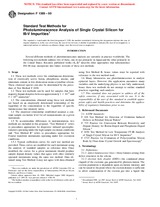Potrebujeme váš súhlas na využitie jednotlivých dát, aby sa vám okrem iného mohli ukazovať informácie týkajúce sa vašich záujmov. Súhlas udelíte kliknutím na tlačidlo „OK“.
ASTM F1389-00
Standard Test Methods for Photoluminescence Analysis of Single Crystal Silicon for III-V Impurities (Withdrawn 2003)
Automaticky preložený názov:
Štandardné testovacie metódy pre fotoluminiscencie analýzy kremíka jednoduchého kryštálu pre III - V nečistôt ( Withdrawn 2003 )
NORMA vydaná dňa 10.6.2000
Informácie o norme:
Označenie normy: ASTM F1389-00
Poznámka: NEPLATNÁ
Dátum vydania normy: 10.6.2000
Kód tovaru: NS-50130
Počet strán: 6
Približná hmotnosť: 18 g (0.04 libier)
Krajina: Americká technická norma
Kategória: Technické normy ASTM
Anotácia textu normy ASTM F1389-00 :
Keywords:
aluminum, arsenic, boron, dopant, impurities, phosphurus, photoluminescence, silicon, ICS Number Code 29.045 (Semiconducting materials)
Doplňujúce informácie
| 1. Scope |
|
This standard was transferred to SEMI (www.semi.org) May 2003 1.1 These test methods cover the simultaneous determination of electrically active boron, phosphorus, arsenic, and aluminum content in low-dislocation mono-crystalline silicon. 1.2 These test methods can be used for samples that have majority dopant densities between approximately 1 X 1011 and 5 X 1015 atoms/cm3. 1.3 The concentrations obtained using these test methods are based on an empirically determined relationship of the logarithm of the concentration to the logarithm of specific luminescence line-intensity ratios. 1.4 The empirical relationship established assumes a constant sample excitation level for all measurements on a given instrument. 1.5 To accommodate differences in instrumentation, two methods are included in this proposal. "Test Method A" refers to procedures appropriate for dispersive infrared spectrophotometers operating under the high sample excitation conditions and "Test Method B" refers to procedures appropriate for Fourier transform instruments operating under low excitation conditions. 1.5.1 Typical calibration curves for each test method are provided. These curves are modified for each instrument using the analysis of standard samples as reference data. Once modified, the curves for a given instrument should produce sample dopant density values that agree with other similarly operated instruments using the same test method. Data obtained using Test Method A may not agree with data obtained using Test Method B, hence values must be reported with reference to the test method used. 1.6 Many laboratories use photoluminescence to analyze epitaxial layers. However this application encounters many variables and the underlying physics is not fully understood; hence these test methods do not attempt to outline standard practices regarding such analysis. 1.7 This standard does not purport to address all of the safety problems, if any, associated with its use. It is the responsibility of the user of this standard to establish appropriate safety and health practices and determine the applicability of regulatory limitations prior to use. |



 Cookies
Cookies
